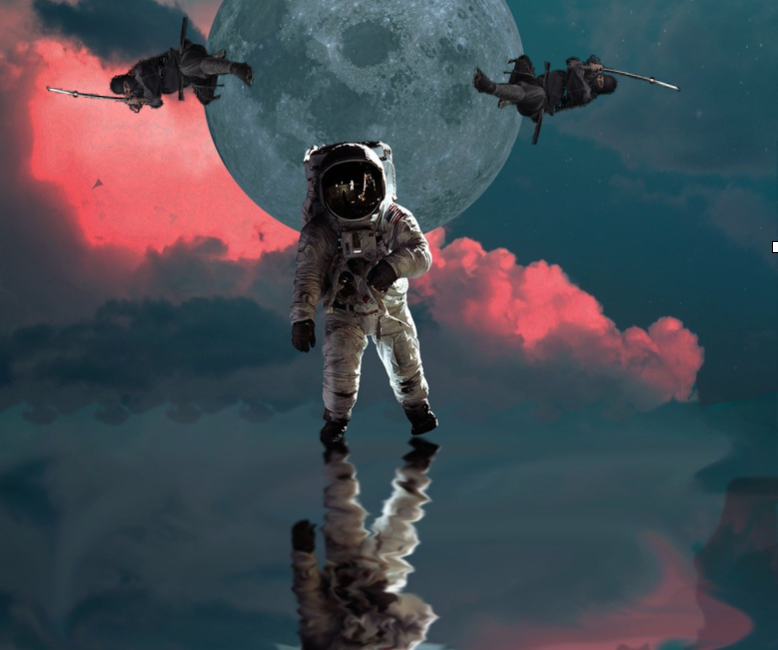Next time you hop aboard a commercial flight to space, take a look back down. You'll see that 70% of our blue planet is covered in water.
Feels good right? Knowing that our bodies consist of approximately 60% water, and that we need 2-3 quarts of fresh water each day to stay alive.
But here's the challenge with this.
Of all the water on Earth, only 3 percent is fresh water. Of all this fresh water, only 1.2 percent of it can be used for drinking. The rest is far out of reach, being deep underground, in glaciers, or in permafrost.
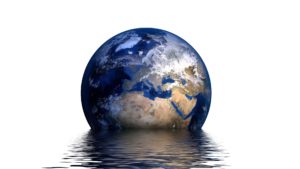 So when you are looking out the spaceship window, less than .025% of what's down there can make it into your astronaut aqua-pack that is attached to the straw in your space helmet. Back on Earth, if you are lost in the wilderness, the deck is already stacked against you.
So when you are looking out the spaceship window, less than .025% of what's down there can make it into your astronaut aqua-pack that is attached to the straw in your space helmet. Back on Earth, if you are lost in the wilderness, the deck is already stacked against you.
In the previous blog, we discussed one of the first priorities for survival— shelter. Let's dive into water for a moment.
It's easy to take fresh drinking water for granted, being so readily available for about 75% of the planet. Still that leaves over 2 billion people who lack access to potable water every day. How tenuous is our access to this fresh water?
 There's a couple ways to look at scenarios that could suddenly cut off our access to water. Survival skills courses often have one consider a situation of being "lost" in the wilderness, and needing to find fresh water to drink. While this happens to a relatively small handful of individuals annually, a more common experience that impacts many people, is that of a natural disaster suddenly shutting off the supply of fresh water. These types of disruptions are happening more frequently, and the topic of something we discussed in a recent blog.
There's a couple ways to look at scenarios that could suddenly cut off our access to water. Survival skills courses often have one consider a situation of being "lost" in the wilderness, and needing to find fresh water to drink. While this happens to a relatively small handful of individuals annually, a more common experience that impacts many people, is that of a natural disaster suddenly shutting off the supply of fresh water. These types of disruptions are happening more frequently, and the topic of something we discussed in a recent blog.
In either type of situation, be it a James Bond scenario where you parachuted out of a burning plane into the wilderness or a sharknado suddenly ripping up all the infrastructure in your town (as well as eating the local water utility worker), there's a helpful ninja perspective to remember...
Adapt.
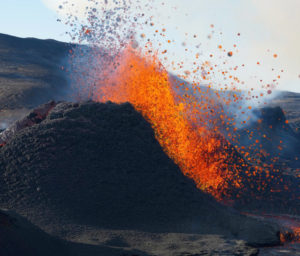 To illustrate this idea, let's go to my favorite layover on the way to Japan from North America...Hawaii. We'll also need to transport via the wayback machine and time travel to pre-European contact times.
To illustrate this idea, let's go to my favorite layover on the way to Japan from North America...Hawaii. We'll also need to transport via the wayback machine and time travel to pre-European contact times.
When I was a biologist in the upper slopes of the volcanoes of Hawaii, I explored a section of the forest on Mauna Loa. My task was to try to find the critically endangered 'Alala, otherwise known as the Hawaiian Crow. Not an easy task. There were less than a dozen birds spread out over 5000 tangled acres.
Many days were spent wandering the forest and listening intently for the distant call of the remaining handful of birds. On one particular day, I was wandering through the forest, when I stumbled across a giant hole in the ground, approximately one hundred feet in diameter and twenty feet deep. This was a collapsed section of an underground lava tube, or "skylight." Typically endangered plants could be found in these holes, because the non-native pigs and feral cows could not get into the holes to eat the rare plants. There often were other surprises to be found in the bottoms of these depressions.
I scrambled down into the bottom of the lava tube skylight by climbing down a small tree that was growing on the inside edge of the collapse. These lava tubes are often long, underground tunnels, sometimes miles long, that formed when hot, fast flowing lava cooled quickly on the top surface. Like a giant plumbing system, once the surface cooled, underground, the lava would continue to flow in these giant cave-like pipe systems all the way to the ocean. Once the flow of lava ceased, the tubes would drain out, leaving a long, empty, underground tunnel. Eventually the ceilings of these tubes would collapse in spots, creating a "skylight" to expose the tube below. Usually, you could find the existing underground lava tube entrances on either side of these collapsed sections.
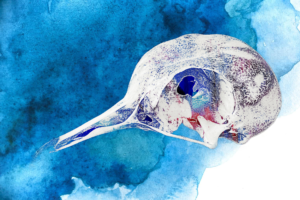 As I reached the bottom of this skylight, I found an entrance to the lava tube on either end of the large hole. The surprise that you often find just inside these entrances, are very unique bones. Before humans arrived on the islands, Hawaii was home to an array of flightless birds. Some, like rails, were relatively small, while others, such as a giant flightless duck, were over four feet tall. For some of these birds, they unfortunately would fall down into these large holes. Without the ability to fly out, they eventually died. Inside the entrances on either end I found piles of such bones. Some of these bones could be thousands of years old. Having spied some, I called for reinforcement.
As I reached the bottom of this skylight, I found an entrance to the lava tube on either end of the large hole. The surprise that you often find just inside these entrances, are very unique bones. Before humans arrived on the islands, Hawaii was home to an array of flightless birds. Some, like rails, were relatively small, while others, such as a giant flightless duck, were over four feet tall. For some of these birds, they unfortunately would fall down into these large holes. Without the ability to fly out, they eventually died. Inside the entrances on either end I found piles of such bones. Some of these bones could be thousands of years old. Having spied some, I called for reinforcement.
A few weeks later, a pair of lava tube paleobiologists ,who specialized in these extinct bird species, arrived. Since this lava tube was not on any maps, they were eager to explore the site. I led them back to the entrance. As I showed them the piles of bones, they picked them up carefully and quickly identified them.
"Flightless rail, over here!" or "Giant duck, over there!" they shouted from inside the tube.
But there was more...
As we wandered into the tube further, they found something in the beam of their headlamps, and called me over to look. On a small shelf on the side of the tube were small black papery piles. "What's that?" I asked.
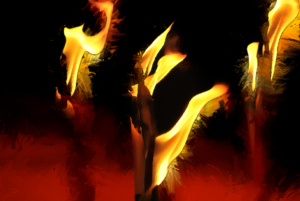 "Those are probably old carbon fragments from an ancient Hawaiian torch. Someone was probably living in this lava tube. They were likely collecting water from the roots coming out of the ceiling up there. They would put gourds below the roots to catch water," one of them said, pointing to the ceiling of the lava tube where the roots of ohia and koa trees dangled down. Small drips of water were slowly dripping off the ends of the roots. I held my hand out and caught one on the tips of my fingers.
"Those are probably old carbon fragments from an ancient Hawaiian torch. Someone was probably living in this lava tube. They were likely collecting water from the roots coming out of the ceiling up there. They would put gourds below the roots to catch water," one of them said, pointing to the ceiling of the lava tube where the roots of ohia and koa trees dangled down. Small drips of water were slowly dripping off the ends of the roots. I held my hand out and caught one on the tips of my fingers.
Before the arrival of Captain Cook to the islands, most of the native Hawaiians lived close to the shore. Relatively few Hawaiians traveled into the "mauka" or higher elevation forests up the sides of the volcanoes except for unique plant gathering, koa or other native tree harvesting for things such as canoes, or perhaps to collect bird feathers for the capes and regalia of the ali'i or Hawaiian royalty. As I wandered the forest, I often wondered how people long ago found fresh water to drink.
Our camp in the forest was rigged with all sorts of tarps to catch fresh rain water, which we mostly used for outdoor showers or cooking. Non-native rats, which often cruised the forest canopy, carry diseases such as leptospirosis, which can get into catchment water. But hundreds of years ago, there weren't many blue polyethylene tarps to rig up in the forest like we had in our camp. The other challenge at this area of the mountain was that there was practically no running water. There are no creeks, springs, or rivers because the ground is predominantly porous lava rock. Even though we received over 100 inches of rain every year, most of it sank quickly into the lava and disappeared.
Seeing the ancient torch fragments and learning about this practice of gathering fresh water was a classic "aha!" moment for me. More than that, it was a realization of humans adapting to the landscape. I can imagine the first person who was really thirsty, happened to be carrying an empty gourd water container, and stumbled into a collapsed lava tube. I imagine them looking up to the ceiling, to the dripping ohia roots and thinking..."aha!"
So, what's our modern "aha" moment that would serve us in a time of need for fresh water?
One of my favorite ways to adapt to a water situation is remembering the old saying— "one person's trash is another's treasure." Literally, I mean trash. But, you need a fire too. That's another skill that we have covered previously. Combine the two and you can purify water.
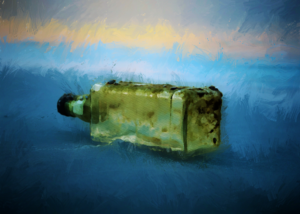 It involves a paper cup, or an empty glass bottle. Unfortunately (fortunately) there are plenty out there to be found in nature. I remember being mesmerized as a youth on a scout camping trip when first shown this technique. Still am. You can place a paper cup full of water on a bed of coals in a fire. The cup won't burn, and eventually the water will boil. Technically speaking, water needs to reach 158° F (70°C) for one minute to kill 99.999% of bacteria, protozoa, and viruses. Since water boils* at 212°F (100°C), this means that by the time water has reached the boiling point, it is safe to drink.
It involves a paper cup, or an empty glass bottle. Unfortunately (fortunately) there are plenty out there to be found in nature. I remember being mesmerized as a youth on a scout camping trip when first shown this technique. Still am. You can place a paper cup full of water on a bed of coals in a fire. The cup won't burn, and eventually the water will boil. Technically speaking, water needs to reach 158° F (70°C) for one minute to kill 99.999% of bacteria, protozoa, and viruses. Since water boils* at 212°F (100°C), this means that by the time water has reached the boiling point, it is safe to drink.
There's many other ways to purify water, or to collect potable water. It's important to know that most streams, lakes, and ponds need to have the water purified before you drink it. Giardia...you don't want it.
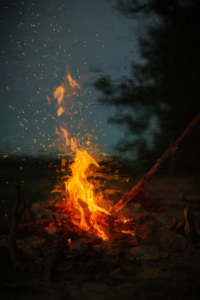 Below is a short video showing one way to boil water with a paper cup on hot coals. You can do this also in a glass bottle, but here's a couple tips I learned the hard way...
Below is a short video showing one way to boil water with a paper cup on hot coals. You can do this also in a glass bottle, but here's a couple tips I learned the hard way...
- some paper cups have weak glue that melts at the seams, causing the cup to fall apart
- some newer brands of glass bottles are made with really thin glass that breaks under heat exposure. Old school, thick, glass bottles work better
You'll have to do your own experimenting. I'm still mesmerized watching water boil in a paper cup. Twists my brain a bit, but then again so does ninjutsu.
For you ninja guardians out there, this is a GREAT one to do with youth. They will remember it the rest of their life. I have so far. You never know. It could even save their life one day.
